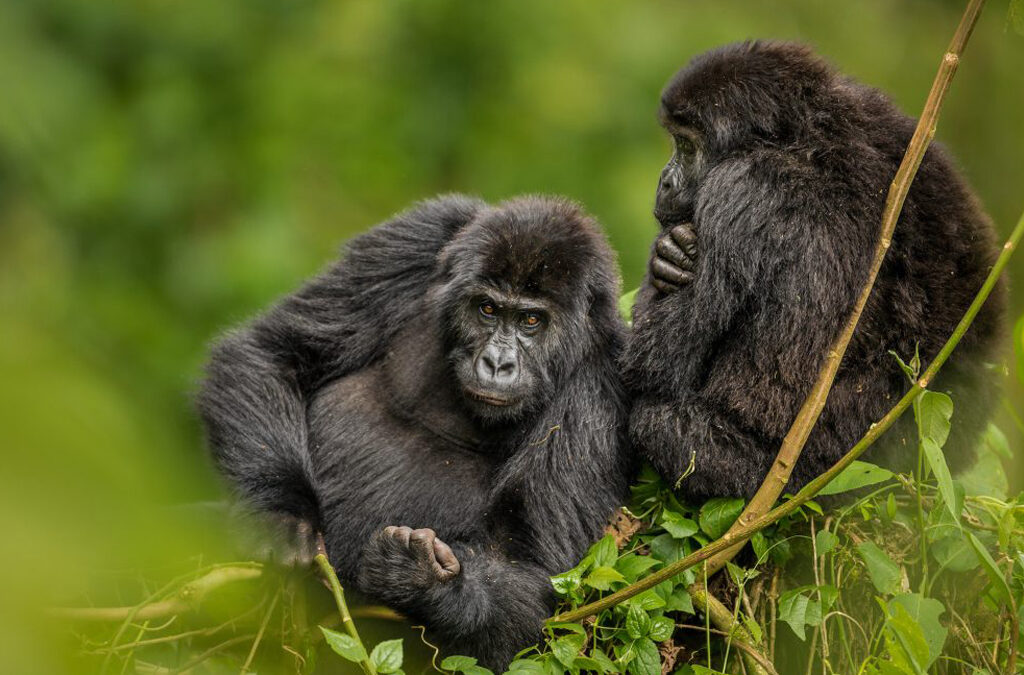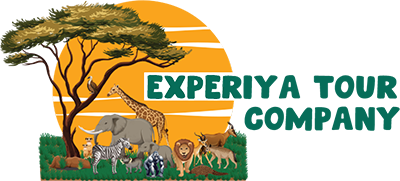- GET IN TOUCH WITH US:
- +256 753518160
- +256 777842166
- info@experiyatourcompany.com

The Cheapest Gorilla Tours in Uganda
October 2, 2025
Is It Safe to Hike Mount Nyiragongo Volcano?
October 3, 2025Gorilla Families in Democratic Republic of Congo

Congo Gorilla Families are among the most fascinating attractions in the Democratic Republic of Congo. Travelers who choose Congo as their gorilla trekking destination are rewarded with the unique opportunity to see both lowland and mountain gorillas. These can be found in three different national parks, each offering not only gorillas but also golden monkeys, bird species, breathtaking mountains, and even active volcanoes.
Gorillas in Virunga National Park
One of the best-known gorilla trekking destinations in Congo is Virunga National Park, which is also famous for its dramatic volcanic landscapes. The park is home to the active volcanoes of Nyamuragira and Nyiragongo. During hikes to Mount Nyiragongo, visitors can even spot glowing lava beneath the earth’s crust, a natural wonder that leaves lasting impressions.
Beyond its volcanic treasures, Virunga is also a sanctuary for both mountain and lowland gorillas. The park shelters golden monkeys—another endangered species—and a variety of other wildlife including elephants, bushbucks, antelopes, amphibians, reptiles, and countless bird species. These features combine to make a gorilla safari in Virunga a lifetime adventure.
Gorillas in Kahuzi-Biega National Park
Congo is blessed with not only mountain gorillas but also the rare Eastern Lowland Gorillas, which are primarily found in Kahuzi-Biega National Park. Unlike their mountain cousins that thrive in high altitudes, eastern lowland gorillas live in lower mountain regions. Kahuzi-Biega provides a distinct gorilla trekking experience, offering encounters with the world’s largest gorilla species.
Gorillas in Maiko National Park
Another important gorilla habitat is Maiko National Park, known for its extraordinary biodiversity. Here, tourists may see lowland gorillas, eastern chimpanzees, African elephants, and numerous other species. As one of the most untouched tourist destinations in Congo, Maiko provides a true wilderness experience.
Virunga Gorilla Families
Although many gorilla families exist across Congo’s national parks, not all are habituated. Only habituated gorillas—those accustomed to limited human presence—are safe and accessible for trekking. In Virunga National Park, several habituated groups are open for tourists, while Kahuzi-Biega has 12 groups, with only four available for trekking.
It is important to note that only eight visitors are allowed per gorilla family each day. This limit helps protect the gorillas’ fragile environment while ensuring a sustainable tourism experience.
Kabirizi Gorilla Family
Kabirizi group consists of 19 members led by the dominant silverback Masibo. Previously, leadership belonged to Ndugutse, who was tragically killed during the first Congo war. Political unrest in the region once caused a dramatic decline in gorilla numbers, yet the Kabirizi group remains a highlight for trekkers. Leadership struggles continue within the group as another silverback challenges Masibo for dominance, making the family dynamic especially intriguing.
Bageni Gorilla Family
Bageni is the largest gorilla family in Virunga, with 26 members. The group is led by Bageni, although silverbacks Kitagenda and Kanamaharagi are increasingly challenging his leadership. Due to these conflicts, experts believe the group may eventually split.
Nyakamwe Gorilla Family
Nyakamwe’s group of 11 members is one of the newest habituated gorilla families in Virunga. Known for its peace and harmony, this family has not experienced major conflicts since habituation. Many compare it to Rwanda’s Amahoro group, celebrated for its calm nature.
Munyaga Gorilla Family
Munyaga’s group is memorable because one of its females, Bilali, once gave birth to twins—an extremely rare occurrence in gorillas. Sadly, the twins did not survive, but their birth still draws interest from visitors. The group is also famous for Kadogo, a bald-headed gorilla whose unique appearance fascinates tourists. Currently, the family is led by Gasure, who dethroned Mawazo after Munyaga, the original leader, disappeared.
Lulengo Gorilla Family
Located in the Joba area of Virunga, Lulengo’s group has nine members. It was named in honor of the park’s technical director, Lulengo, who died in a landmine explosion. The family is known for its peaceful nature, much like the Nyakamwe group, and provides an excellent trekking experience.
Humba Gorilla Family
Humba’s group consists of nine members and is considered one of the calmest families in the park. Humba and his brother Nyakamwe originally split from the Rugendo family in 1998 to start their own groups. Since then, Humba’s family has steadily grown and remains among the easiest to trek.
Rugendo Gorilla Family
Rugendo’s family, once numbering 18 members, has faced significant turmoil due to political unrest and armed conflict. Several gorillas, including Rugendo himself, were killed in clashes. Leadership later passed to his son Senkwenkwe, who was also killed, followed by Bukima. Today, the family has nine members, including three silverbacks, one female, three blackbacks, and two babies.
Mapuwa Gorilla Family
Mapuwa, another son of Rugendo, broke away to form his own group in the Jomba region. Initially leaving with two females, Mafaze and Jicho, Mapuwa expanded his family by attracting members from other groups. The family now has 22 members and is led by the strong silverback Mvuyekure.
Kahuzi-Biega Gorilla Families
Tourists visiting Kahuzi-Biega National Park also have the chance to trek habituated gorilla families. While the park has 12 groups, only four are open for visits.
Chimanuka Gorilla Family
Chimanuka’s group is the largest in the park, with more than 37 members. Remarkably, the group has four sets of twins, making it especially fascinating for tourists. The dominant silverback, Chimanuka, ensures strong leadership.
Mugaruka Gorilla Family
Mugaruka, the dominant silverback of this group, lost his right hand in a poacher’s snare at the age of three. Despite his disability, he rose to become a powerful leader. Over the years, he has faced challenges, particularly from Chimanuka, but continues to fight for his family.
Mpungwe Gorilla Family
Named after River Mpungwe, this group is led by the dominant silverback Mpungwe. Known for his aggressive yet controlled nature, he maintains discipline within the group while remaining tolerant of tourists.
Bonnani Gorilla Family
Bonnani’s group is the smallest habituated family in Kahuzi-Biega, with only five members. As one of the newest groups to be habituated, it offers an intimate trekking experience.
Best Time to Visit Congo Gorilla Families
The best time to visit gorilla families in Congo is during the dry seasons, from June to August and from December to February. During these months, the hiking trails are easier to navigate, especially in Virunga where many gorilla families live on mountain slopes. In contrast, the rainy season makes trekking more difficult due to slippery trails.
